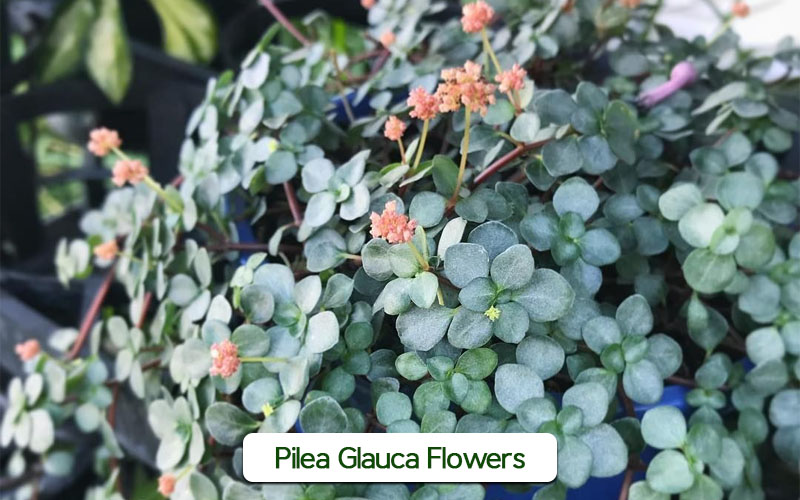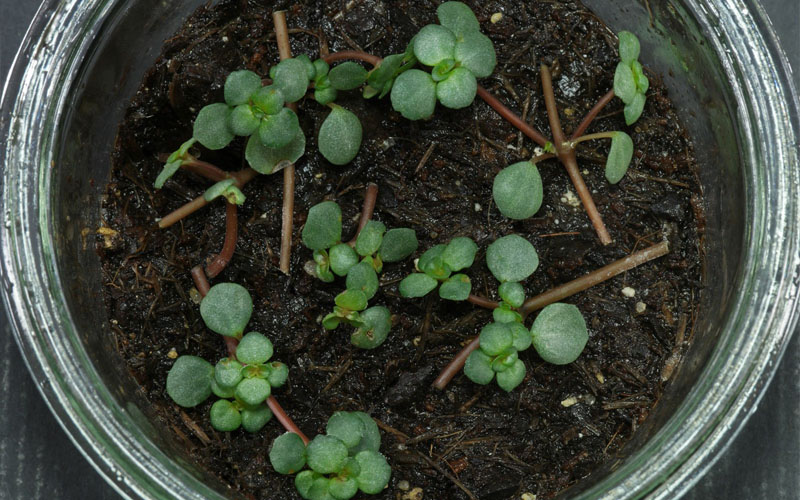Pilea Glauca care, a query many of our regular visitors send us. So, we decided to cover it from all the angles and sides and generated a deep guide on pilea Glauca care.
Who should read it?
You, if your pilea Glauca is dying, giving you a hard time, showing confusing growth patterns, or not growing at all – this guide is for you.
We will discuss everything in detail:
Table of Contents
Pilea Glauca:

If you write pilea on google, you will find Pilea peperomioides or the lucky Chinese money plant. Yes, it is the most famous variety of the genus pilea.
However, Glauca is the less-famous yet one of the special decorative house plants known for the silvery dust on its leaves, called fairy dust.
Overview of the Pilea Glauca plant:
| Biological name | Pilea glauca |
| Genus | Pilea |
| Family | Urticaceae |
| Common name | Silver Sparkle Pilea, Pilea libanensis, Aquamarine, pilea glauca baby tears, Red-stemmed Pilea, Grey Artillery Plant |
| Type | succulent, decorative houseplant |
| Famous for | tiny cascades of sparkling leaves |
| Care | Very easy |
Pilea Glauca Flowers:

Yes, mature pilea Glauca plants do bear flowers. Flowers grow in clusters and can be of white, peach, or pink color.
The flowering season is of course the blooming season. Once the blooming season is over, pilea Glauca flowers vanish.
You need to wait for the next blooming spring season to get pilea Glauca flowers.
Pilea Glauca Stem:

Pilea Glauca is known as red-stemmed Pilea just because of the bright red lively stem. Yes, you find red-colored stems in pilea Glauca that bears sparkly greyish leaves.
Pilea Glauca Leaves:

Pilea Glauca has tiny leaves that also grow in clusters.
Pilea Glauca is actually a spring of colors that has a warm red stem, greyish cascading leaves that grow in clusters, making it look like flowers.
The best thing about pilea Glauca is the silver shimmery powder on the leaves that lays naturally on there but looks extremely, extremely fascinating to see.
Pilea Glauca Growth Rate:
The growth rate of this plant is very high and it grows quickly during summers and spring. As winter is not a growing season, so these days you may experience and slow growth.
Pilea Glauca is a non-toxic, must-have plant for your home.
When you have, here is how you can take good care of this plant.
Glauca Pilea Plant Care:
In a nutshell, pilea Glauca needs indirect sunlight, a well-draining potting mix, moderate humidity, and very light fertilization.
Here’re the details:
1. Placement / Light:

Before you bring it home, you will have to decide on a perfect room for your plant. A room with a west-facing window, or an east-facing window with drapes, will be an ideal home for your pilea Glauca.
At dawn time, two hours meeting with the sun is great but not more than that.
If the room receives sunlight for most parts of the day, ensure to place drapes on the window causing a shadow between Glauca and the sun.
2. Humidity:
Succulents love humidity. But pilea Glauca can do best even in moderate room-level humidity. This is about summers.
In winters when there is more than needed dryness and low humidity levels, you may have to opt for some methods to maintain moisture the moisture level around your little pilea Glauca baby tears.
For this you can:
- Grow grass and place pilea along with other plants there, it will increase the humidity levels)
- Place plant in the tray and terra cotta pots, fill trays with water to increase humidity
- Use artificial humidifiers.
- Transfer your succulent to bathrooms
You may also have to move the plant from a hot room to a rather cold room with an asphyxiated environment.
3. Maintaining Temperature:

Pilea Glauca is the most easy-going house member of your family. It doesn’t have any special temperature requirements but thrives well at room temperature.
You don’t need to do anything specific during normal weather, but you need a little extra care when the temperature changes and gets cold so is the pilea Glauca.
Therefore, when it is cold, you will have to increase the temperature a little and humidity a little more around your plant.
4. Watering Requirement:
Being succulent, Pilea Glauca stores water in it. The bloated leaves keep water inside and sip on them for many days.
Therefore, heavy watering is not recommended for this plant but you need to be restrained when watering this beautiful baby tear plant.
How to water is another thing where most of the gardeners make mistakes and end up having a rotting plant.
Water this plant only when you find the upper ground of the pot is dried out. Also, when you water, make sure the water reaches the roots but never stays there.
Letting your pilea Glauca sitting in water for too long means killing your plant and making it weak with your own hands.
Besides this, under watering can also cause damage to your plant. Curled, crisped, or puckered leaves. The wilting is because of the dryness caused by not having enough water.
Some people also write that the leaves of their Pilea Glauca are getting yellow spots despite giving their water enough and moderate water- just apt to the requirement.
Well, the answer to your query is the quality of water. Poor-quality water can cause yellow spots under the leaves. To get rid of this, give fresh and purified water to drink to your glauca plant.
5. Pot Selection:
Pilea Glauca aquamarine plants stay very happy in the terra cotta pots with a drainage hole at the bottom.
This drainage hole helps to ditch the excessive water out of the plant and never cause root rot.
Therefore, whenever you bring a pot home for this specific plant or any succulent that requires quick draining, use terra cotta pots for them.
6. Soil:
The soil as said earlier should be a well-draining potting mix. Here, let us explain what a well-draining potting mix soil is.
Well, organic soil with no tightly tightened particles that let the water drain through it and reach all the parts of the plant is a well-drained potting mix.
To create a perfect potting mix, you can use 50% organic soil and 50 % perlite.
7. Fertilizers:
Pilea Glauca fertilizers are offered with a portion control method.
The plant doesn’t like huge seasonal fertilizing but regular fertilization on a monthly basis.
You can choose between organic and chemical fertilizers but make sure to put in the right quantity.
For example, organic soil is not that hard however, its nutrient value is low. On the other hand, chemical fertilizers provide good nutrients but they can be a little hard on the plant.
To avoid buildup of the residual, mix the soil with water so that it reaches all parts of the plant.
8. Pruning:
Pruning pilea Glauca grey baby tears is not that hard because of its cute tiny size. The plant is tiny and small which makes it easy to prune.
Usually, Pilea Glauca doesn’t need special or specific pruning because the higher the growth is the more beautiful this plant will be.
When it comes to pruning check out any damaged leaves or dead stems, cut them off, and that’s all for the pruning.
9. Repotting:
Repotting the plant is only required after two to three years. Because, the soil inside the pot loses its nutrients after some years, and hence the new soil is needed or required.
The plant doesn’t grow out of this pot or gets bigger in size. Therefore, choose the same size pot for every next time.
You can also simply change the soil of the same pot after one, two, or three years to keep your plant happy.
How to Propagate Pilea Glauca?

Pilea Glauca the silver sparkler is a fast grower hence propagating it is very easy and effortless. Here is how you can propagate the pilea through a stem cutting.
- Get terra cotta pot
- Put well-draining potting mix in it
- Get some inches long stem cutting with fresh leaves on it
- Place inside the soil and let it be there
- Water
- Fertilize
- And see it thriving
Make sure to take good care of the placement. Also, if you need ground coverage, you can go for sowing multiple stem cuttings.
Pilea Glauca Toxicity:

Pilea Glauca is not toxic to cats or dogs or humans. You can have this plant confidently at your home.
Bottom Line:
This is all about Pilea Glauca. We have tried to cover all the necessary things. However, if you have any more queries in mind which we couldn’t cover, let us know by commenting below.
We love hearing from you.

